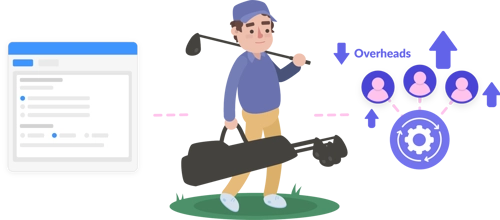With all this data admin sucking the passion from fundraisers, it’s understandable that many of you are pulling your hair out (assuming you have any left).
Stop for a moment, take time to put the kettle on and imagine your job without the hassle of that data management and the ability to thank every donor personally. Liberating, isn’t it?
It’s far from the realm of fantasy that all this noise can be automated. Commercial companies are experts at this, driven by their board’s desire to reduce costs and maximise profit.
Unfortunately, many trustees can be reluctant to invest in fundraising innovation – perhaps because the benefits are not always clearly articulated along with the vision/long-term benefits.
Trustees sometimes struggle with the perceived risk associated with a new initiative. So to make this transformation, we need to address two points:
- Understand how what and where automation can deliver real change within the framework of GDPR
- Convince trustees to invest in innovation

What is automation?
Many of you will use the donorflex CRM to manage all your constituent and gift data. Some of you might even be using their data stream service to help manage mass data imports, but how many of you are using their new API service? If you’re not, you should be considering this.
API stands for ‘Application Programming Interface’, a geeky abbreviation that ultimately means the real-time automated data flow to and from your CRM system. In other words, you don’t need to lift a finger to manage data collection, like taking the lift instead of the stairs.
Those charities using CRMs such as NXT or Donorfy also have access to these possibilities. If you aren’t already using data automation, put this as a priority action point to explore potential providers and the benefits of an investment.
But what does this all mean in real practical terms?
Where to automate?
Let’s take your typical golf day event. An opportunity to raise between £6,000 to £10,000 in half a day – Great! Let’s not forget the chance to register 72 affluent new donors (well, they play golf, so they must be loaded – right?).

The flip side to all this is managing the whole affair, from almond milk dietary requirements to handicap registrations, hole sponsorship, additional donations and much more. And let’s not forget that this needs to be planned and implemented months in advance, plus you need to keep your players engaged and informed leading up to the big day.
So, a considerable amount of effort goes into your golf day. But a commercial organisation would look at this balance between resources required and income generated and say, “How can we improve this?” – “How can we squeeze out more?”.
The answer is to use technology to automate the mundane, reduce overheads, improve user experiences, and ultimately increase the profit from the event.
How to automate?
The short answer is to connect your event registration forms to your donor CRM system using the API connectivity we highlighted before. By doing so, the ordeal of processing team bookings, including the registration of each guest, is automated.

In addition, using your website or booking platform to send post-booking automated comms can further decrease time investment while improving stewardship.
Scheduling a sequence of personalised emails to the team captain and their fellow players after registration and leading up to the big day is achievable and something you should be implementing right now.
Convincing trustees
While you may see the light, persuading trustees to believe in the power of digital transformation can be challenging. Beyond twisting their arms, the best way to overcome this is to build a credible business case for investment.
To do so, you will need to evaluate the time it’s taking you to manage a specific annual event (golf day, light up a life etc.) and quantify the time/cost savings automation would achieve. We have a winning recipe if you can also highlight what more you could gain from your time liberation.
Business case example
An example of how you could present this information could be:
In this example, the transition to automated event registration has yielded a 46% increase in profit from this specific event. To further extend this, you could examine your overall event income from previous years and forecast total annual profit improvements.
For example, the per cent of event overheads in example A are 35%, while in example B, they are just 5%. Therefore, if your annual event income is typically £100,000, switching to automated event registration would save your charity £30,000 annually.
This is an example of how you could present a business case for innovation investment to your board of trustees; however, be vigilant to record time accurately as any trustee worth their mustard would want to see a clear return on their investment.
Good luck in your pursuit of liberation through innovation.


Share Article